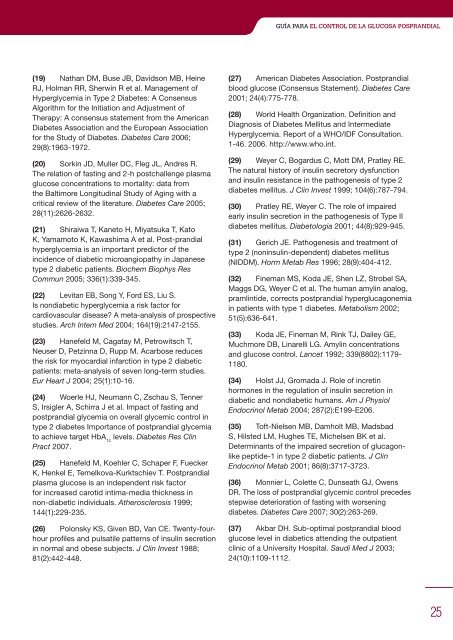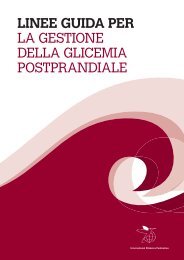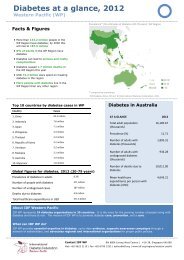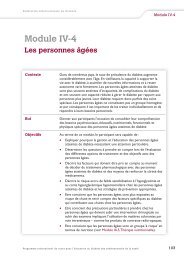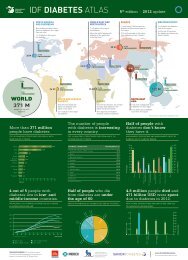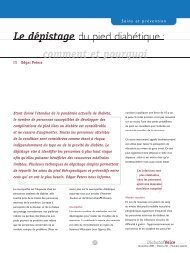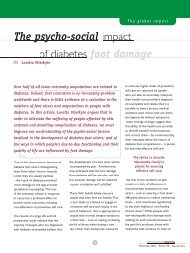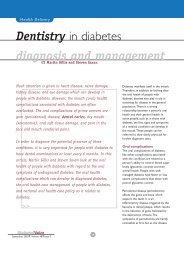guía para el control de la glucosa posprandial - International ...
guía para el control de la glucosa posprandial - International ...
guía para el control de la glucosa posprandial - International ...
Create successful ePaper yourself
Turn your PDF publications into a flip-book with our unique Google optimized e-Paper software.
(19) Nathan DM, Buse JB, Davidson MB, Heine<br />
RJ, Holman RR, Sherwin R et al. Management of<br />
Hyperglycemia in Type 2 Diabetes: A Consensus<br />
Algorithm for the Initiation and Adjustment of<br />
Therapy: A consensus statement from the American<br />
Diabetes Association and the European Association<br />
for the Study of Diabetes. Diabetes Care 2006;<br />
29(8):1963-1972.<br />
(20) Sorkin JD, Muller DC, Fleg JL, Andres R.<br />
The r<strong>el</strong>ation of fasting and 2-h postchallenge p<strong>la</strong>sma<br />
glucose concentrations to mortality: data from<br />
the Baltimore Longitudinal Study of Aging with a<br />
critical review of the literature. Diabetes Care 2005;<br />
28(11):2626-2632.<br />
(21) Shiraiwa T, Kaneto H, Miyatsuka T, Kato<br />
K, Yamamoto K, Kawashima A et al. Post-prandial<br />
hyperglycemia is an important predictor of the<br />
inci<strong>de</strong>nce of diabetic microangiopathy in Japanese<br />
type 2 diabetic patients. Biochem Biophys Res<br />
Commun 2005; 336(1):339-345.<br />
(22) Levitan EB, Song Y, Ford ES, Liu S.<br />
Is nondiabetic hyperglycemia a risk factor for<br />
cardiovascu<strong>la</strong>r disease? A meta-analysis of prospective<br />
studies. Arch Intern Med 2004; 164(19):2147-2155.<br />
(23) Hanef<strong>el</strong>d M, Cagatay M, Petrowitsch T,<br />
Neuser D, Petzinna D, Rupp M. Acarbose reduces<br />
the risk for myocardial infarction in type 2 diabetic<br />
patients: meta-analysis of seven long-term studies.<br />
Eur Heart J 2004; 25(1):10-16.<br />
(24) Woerle HJ, Neumann C, Zschau S, Tenner<br />
S, Irsigler A, Schirra J et al. Impact of fasting and<br />
postprandial glycemia on overall glycemic <strong>control</strong> in<br />
type 2 diabetes Importance of postprandial glycemia<br />
to achieve target HbA 1c lev<strong>el</strong>s. Diabetes Res Clin<br />
Pract 2007.<br />
(25) Hanef<strong>el</strong>d M, Koehler C, Schaper F, Fuecker<br />
K, Henk<strong>el</strong> E, Tem<strong>el</strong>kova-Kurktschiev T. Postprandial<br />
p<strong>la</strong>sma glucose is an in<strong>de</strong>pen<strong>de</strong>nt risk factor<br />
for increased carotid intima-media thickness in<br />
non-diabetic individuals. Atherosclerosis 1999;<br />
144(1):229-235.<br />
(26) Polonsky KS, Given BD, Van CE. Twenty-fourhour<br />
profiles and pulsatile patterns of insulin secretion<br />
in normal and obese subjects. J Clin Invest 1988;<br />
81(2):442-448.<br />
GUÍA PARA EL CONTROL DE LA GLUCOSA POSPRANDIAL<br />
(27) American Diabetes Association. Postprandial<br />
blood glucose (Consensus Statement). Diabetes Care<br />
2001; 24(4):775-778.<br />
(28) World Health Organization. Definition and<br />
Diagnosis of Diabetes M<strong>el</strong>litus and Intermediate<br />
Hyperglycemia. Report of a WHO/IDF Consultation.<br />
1-46. 2006. http://www.who.int.<br />
(29) Weyer C, Bogardus C, Mott DM, Pratley RE.<br />
The natural history of insulin secretory dysfunction<br />
and insulin resistance in the pathogenesis of type 2<br />
diabetes m<strong>el</strong>litus. J Clin Invest 1999; 104(6):787-794.<br />
(30) Pratley RE, Weyer C. The role of impaired<br />
early insulin secretion in the pathogenesis of Type II<br />
diabetes m<strong>el</strong>litus. Diabetologia 2001; 44(8):929-945.<br />
(31) Gerich JE. Pathogenesis and treatment of<br />
type 2 (noninsulin-<strong>de</strong>pen<strong>de</strong>nt) diabetes m<strong>el</strong>litus<br />
(NIDDM). Horm Metab Res 1996; 28(9):404-412.<br />
(32) Fineman MS, Koda JE, Shen LZ, Strob<strong>el</strong> SA,<br />
Maggs DG, Weyer C et al. The human amylin analog,<br />
pramlinti<strong>de</strong>, corrects postprandial hyperglucagonemia<br />
in patients with type 1 diabetes. Metabolism 2002;<br />
51(5):636-641.<br />
(33) Koda JE, Fineman M, Rink TJ, Dailey GE,<br />
Muchmore DB, Linar<strong>el</strong>li LG. Amylin concentrations<br />
and glucose <strong>control</strong>. Lancet 1992; 339(8802):1179-<br />
1180.<br />
(34) Holst JJ, Gromada J. Role of incretin<br />
hormones in the regu<strong>la</strong>tion of insulin secretion in<br />
diabetic and nondiabetic humans. Am J Physiol<br />
Endocrinol Metab 2004; 287(2):E199-E206.<br />
(35) Toft-Ni<strong>el</strong>sen MB, Damholt MB, Madsbad<br />
S, Hilsted LM, Hughes TE, Mich<strong>el</strong>sen BK et al.<br />
Determinants of the impaired secretion of glucagonlike<br />
pepti<strong>de</strong>-1 in type 2 diabetic patients. J Clin<br />
Endocrinol Metab 2001; 86(8):3717-3723.<br />
(36) Monnier L, Colette C, Dunseath GJ, Owens<br />
DR. The loss of postprandial glycemic <strong>control</strong> prece<strong>de</strong>s<br />
stepwise <strong>de</strong>terioration of fasting with worsening<br />
diabetes. Diabetes Care 2007; 30(2):263-269.<br />
(37) Akbar DH. Sub-optimal postprandial blood<br />
glucose lev<strong>el</strong> in diabetics attending the outpatient<br />
clinic of a University Hospital. Saudi Med J 2003;<br />
24(10):1109-1112.<br />
2


